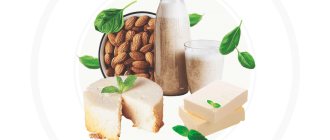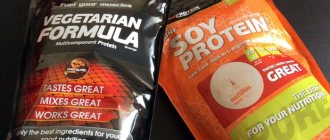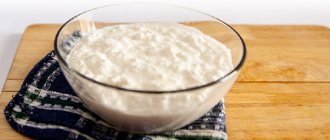Why protein in the diet is vital for the body
Protein in nutrition: Role for health, sources, norms Photo: Depositphotos
Protein is a building material for our body, so getting it with food is a vital necessity. Let's take a closer look.
Protein is a complex organic compound. It consists of a chain of amino acids, of which there are only 20. But in the chains, amino acids are combined in different ways - about a hundred thousand different proteins are obtained.
Cells, tissues and organ systems are built from proteins alone. Others help restore them and participate in chemical processes. But the body produces only part of the necessary amino acids. We get the rest from food.
What are proteins responsible for in the body?
- They accelerate chemical processes - enzyme proteins are responsible for this. Many chemical reactions involving enzymes occur in the cells of the body.
- They supply energy - it is released during the breakdown of proteins during digestion.
- They deliver oxygen to each cell and carbon dioxide back to the lungs - this role is performed by the protein hemoglobin.
- Hormones regulate chemical processes - the proteins insulin, somatotropin, and glucagon are involved.
- They protect against bacteria and viruses - in response to the invasion of pathogens, the body produces immunoglobulins, or more simply, antibodies.
- Provide chemical protection - bind toxins. For example, liver enzymes break them down or convert them into a soluble form. This allows you to quickly remove poisons from the body.
- They form the “framework” of the cell - give it shape. The structural proteins collagen and elastin are the basis of connective tissue. Keratin forms hair and nails.
These are not all the functions of proteins in the body. But they clearly show how important proteins are for life and health.
How protein in the diet improves quality of life
Protein-rich foods create a feeling of fullness for a long time - a person does not need to constantly snack. This allows you to control your weight and not gain extra pounds. When doing fitness, nutritious protein foods help muscles grow faster.
Proteins also heal and rejuvenate the body:
- Impurities, toxins and excess fluid go away, and along with them - puffiness, volume and unhealthy complexion.
- A clear head means a person thinks faster and remembers better.
- Skin, hair and nails in good condition are an attractive appearance.
- A person is always “in good shape” and in a positive mood.
- Increases resistance to stress.
What it is
In scientific language, proteins (proteins) are high-molecular organic substances consisting of amino acids.
Proteins are found in absolutely all cells of our body, most often they account for 50% of dry mass. Proteins are complex molecules that can participate in a wide variety of interactions and connections. We can say that these are “bricks” that act not only as a building material, but also as a carrier of other substances and even as a “conductor” in complex chemical reactions. Every protein is made up of amino acids.
There are 21 amino acids in the human body, but only 8 of them are vital, and therefore are called essential. These are valine, leucine, isoleucine, lysine, methionine, threonine, tryptophan, phenylalanine. A person is not able to synthesize them on his own, so he must receive them from food.
What are the dangers of protein deficiency for the body?
If the body does not receive enough amino acids, metabolic processes begin to malfunction - this leads to serious illnesses. The cells of the body give birth to unhealthy offspring, so a person ages faster.
The quality of life deteriorates sharply:
- There is a tendency to depression.
- The body lacks energy - chronic fatigue occurs.
- Hunger manifests itself more often and pushes you to unhealthy snacks, and this leads to surges in blood sugar with all the consequences - heart disease, diabetes, excess weight.
- Mental activity decreases.
- The immune system suffers - a person often suffers from colds and acute respiratory viral infections.
- Hair falls out, nails break, skin dries and peels.
Protein deficiency is especially dangerous for children, adolescents and pregnant women.
Habitats
Squirrels live everywhere: throughout Europe, most of Asia, Russia and even on many islands. However, you will not find it in Australia or Madagascar.
They prefer to settle in forest and park areas where trees grow abundantly. They adapt well to both cold and heat.
They take refuge in trees, most often choosing coniferous ones, but they will not disdain deciduous ones. They can change their home if the year turns out to be a bad harvest and settle in another place. They often live in cedar forests due to the abundance of their favorite foods.
It can easily get along with people, and perhaps sees this as a definite plus for itself - people usually feed these funny animals, especially in the cold.
Now you can have squirrels as a pet, but you should not bring them from the forest to your home. Such individuals will most likely die in unusual conditions or due to stress. They are also carriers of dangerous diseases that can be transmitted to humans. If you want to have this cute creature at home, be sure to buy it only in specialized stores and bring it home after examination by a veterinarian.
What foods contain protein?
Protein in nutrition: Role for health, sources, norms Photo: Depositphotos
Proteins are found in foods of both animal and plant origin. Each type of protein is good in its own way and has its own characteristics. They need to be taken into account when planning your diet.
Plant protein takes longer to digest than animal protein. To cover the daily requirement, you need to eat a lot. But during heat treatment it does not lose its properties.
Animal protein is quickly absorbed and the daily requirement can be obtained from a small amount of food. But such products are often fatty - and this is not very healthy.
Nutritionists advise including both types of protein in the menu - this way the body will receive a full set of amino acids.
Animal products
Animal proteins in the diet can be obtained from meat, fish, seafood, dairy, and eggs.
Meat, poultry
The main source of protein is meat.
Protein is most easily absorbed from poultry meat - chicken is considered the best. In second place is lean beef. Lean pork is preferable - it has more protein than fatty pulp.
Offal products - liver, kidneys, heart - are also rich in proteins.
Nutritionists classify boiled, stewed, steamed or baked dishes as “correct”. It is not recommended to fry meat - the cooking process produces trans fats that are harmful to the body.
Fish and seafood
Fish is lighter than meat. A good solution for those who are on a diet. The first place in the health rating is occupied by salmon - in addition to healthy protein, they contain omega-3 fatty acids.
Seafood is also rich in proteins. This also includes caviar and fish milt.
Eggs
Easy-to-digest proteins plus a whole storehouse of vitamins and minerals - that’s what eggs are on our menu. This is a good alternative to meat dishes.
Fermented milk
We are talking about natural fermented milk products without preservatives and other “additives” in the form of flavor enhancers, dyes, stabilizers, etc. Whey protein is a valuable component that strengthens the immune system, provides a feeling of satiety, and improves the condition of the skin, hair, and teeth.
Fermented milk products are the basis of many diets. These include cottage cheese, fermented baked milk, kefir, and natural yogurt. They are absorbed instantly and provide the same benefits to the body as proteins from meat and fish.
The most whey protein is found in cheese, whey and low-fat cottage cheese.
Plant Protein Products
Protein is found in many plant foods, including vegetables. It is the main source of protein for vegetarians and dieters. But nutrition experts recommend plant-based protein products for those who eat meat.
Nuts, seeds
Seeds and nuts contain a lot of vegetable protein. These include hemp seeds, sunflower seeds, flax seeds, pumpkin seeds, sesame seeds and various nuts - almonds, hazelnuts, cashews, peanuts, pistachios, Brazil nuts and walnuts.
Legumes, cereals, grains
Rich sources of vegetable protein include legumes: beans, green peas, chickpeas, lentils. This is a complete alternative to animal products.
Cereals allow you to quickly fill the protein gap. In addition, they contain polyunsaturated fatty acids, which improve metabolism. And they are rich in fiber - it normalizes the functioning of the digestive system.
All these products are widely used in vegetarian and dietary cuisine.
Vegetables
Vegetables have much less protein than legumes and seeds. But the most “protein-containing” ones are considered to be: cabbage, bell peppers, beets, spinach, asparagus, carrots, tomatoes, cucumbers, parsley.
Fruits and berries
Small amounts of vegetable protein are found in many fruits and berries - figs, bananas, apricots, pears, apples, cherries, cherries, strawberries, plums, black currants, sea buckthorn, etc.
Other sources of plant protein
The list of sources of plant protein is supplemented by cocoa powder, mushrooms, seaweed - especially spirulina, which is produced in the form of a biologically active food supplement. In addition to protein, it contains iodine and many useful minerals.
Best Sources of Plant Protein
- Pumpkin seed protein
In terms of the amount of amino acids they contain, pumpkin seeds are almost equivalent to the ideal balance of animal protein in eggs. They contain a lot of lysine, phenylalanine and tryptophan - amino acids involved in the metabolism of neurotransmitters and in the formation of collagen fibers.
In addition, the seeds do not contain protease inhibitors - enzymes that break down bonds in the protein molecule. It is recommended to consume peeled seeds regularly.
- Amaranth protein
Amaranth contains twice as much protein as wheat. The huge content of tyrosine, tryptophan, threonine, phenylalanine brings it closer in amino acid composition to milk protein. The grain of this crop consists of 11-19% protein, so it can be used to easily compensate for deficiencies - especially for adherents of a plant-based diet.
- Cereal proteins
The most useful from this point of view are buckwheat, quinoa and oats. But in any case, cereal proteins do not have an ideal amino acid composition. Only buckwheat and oats are rich in lysine; buckwheat, as well as sorghum and rice, are rich in isoleucine. Wheat, barley, rye and sorghum have too little methionine, only 1.6 - 1.7 mg/100 g of protein. Wheat protein contains only 2.6% threonine, while corn contains too little tryptophan (0.6%).
In general, even with a combination of these cereals, covering the body’s daily protein needs is still a big question.
- Legume protein
Legume protein is very cheap and very popular. However, there is one important drawback: it contains protease inhibitors, which prevent the complete digestion of protein.
Pea protein is high in essential amino acids but not rich in sulfur-containing amino acids. For this reason, legume protein should be used in combination with other types of protein.
We recommend
“The benefits of water for the human body” Read more
How much protein does the body need per day?
The adult body requires at least 0.8 g of high-quality protein per day per kilogram of weight. This means that if you weigh 75 kg, you need to eat at least 60 g of protein daily. And better - more.
Protein in nutrition: Role for health, sources, norms Photo: Depositphotos
Some categories of people need an increased daily protein intake. These include:
- Nursing mothers. In order for milk to be produced normally, their diet should contain 20 g more protein than during pregnancy.
- Older people should receive 1-1.5 g of protein per kilogram of weight daily.
The effect of protein on human satiety control
Scientists have noticed that some animals begin to behave differently due to fluctuations in protein in their diet. This is the so-called protein lever hypothesis. Its meaning is that our smaller brothers first try to fill the body with protein, and only then load up on carbohydrates and fats. Thus, they control overeating as protein reduces hunger.
Macronutrient fluctuations were described using a mathematical model. She proved that different people around the world consume protein within 10-15%, but the proportions of fat and carbohydrates are very different. Our hunter-gatherer ancestors ate high-protein foods, which made up 20-30% of their total diet.
Many people believe that to lose weight and maintain weight, you just need to increase your protein intake. However, scientists have conducted a number of studies and found that the diet of overweight people contains almost the same amount of protein as thin people. Thus, weight loss is influenced not so much by increasing protein, but by reducing the amount of foods with a high glycemic index. In addition, it has been proven that long-term protein diets lead to health problems.
At the same time, the positive effect of proteins on the human body cannot be denied. Protein perfectly saturates the body and helps control hunger. How to use this property of protein leverage wisely?
- The right food. It is better to give preference to whole foods containing protein and not to abuse their combinations with fats and carbohydrates (for example, eating potatoes and meat together). Because in this case, in order to gain the protein norm, you will have to eat too many carbohydrates and fats “for company.”
- Protein for breakfast. This method is guaranteed to reduce appetite during the day by 51%. The first meal with a high protein content is justified and even recommended for everyone who is concerned about and monitors their figure and body quality in general.
- It is recommended to start any meal with protein. I immediately remember the ancient expression “Ab ovo”, which translated means “let's start with an egg.” Protein at the beginning of your meal, like a vegetable salad, helps reduce the number of calories you consume.
- On days when you have a strong appetite, eat plenty of protein. And during periods of rest, reduce its amount by taking a break.
Are all proteins in the diet healthy?
Not all protein products are beneficial to the body. It's all about preservatives and additives that are used to enhance taste and smell. Because of them, meat products become not just unhealthy, but even harmful.
This category includes products made from processed meat - sausages, smoked delicacies, sausages, pates. They contain a huge amount of “additives” that provoke all sorts of diseases - from migraines to high blood pressure.
Another group of harmful products is meat and fish semi-finished products. In addition to flavor enhancers, they add reagents that retain moisture.
Red-tailed squirrel
Their habitat is the tropical forests of Central and South America.
The animal of this species has a rich red tail and a body length of 30 to 50 cm, which distinguishes it from other fur-bearing animals.
How to increase the amount of healthy protein in your diet
To eat as much healthy protein as possible, adjust your diet: replace processed carbohydrates with protein foods.
For example, snack not on chips and crackers, but on nuts and dried fruits. Instead of baked goods and sweets, eat Greek yogurt with berries or slices of fresh fruit. Replace pizza with omelet or baked fish.
The amount of protein in the finished dish depends on the method of processing the meat. It is best to boil, stew or bake.
The body fully absorbs 30-35 g of protein in one meal. Therefore, 5-6 meals a day in small portions is more effective than the classic three meals a day.
A glass of kefir half an hour to an hour before bedtime will increase the amount of healthy protein in your diet.
Common squirrel
The most popular variety of the squirrel family. Habitat: Eurasian territory from Ireland to Japan.
In addition, the squirrel is not afraid to live close to people. We can see this while walking through a forest or park area. Fur color is red.
Lifestyle and habits
They do not live in flocks or pairs, almost always staying alone. Squirrels are very mobile and it is quite difficult to identify their specific habitat. The squirrel spends most of its life in trees, moving from one to another by jumping. And in this she is helped by her rather large tail, which she uses as a rudder. The squirrel's long jump can be up to several meters, which is quite significant given the size of its body. A squirrel can jump much further to the bottom, up to fifteen meters.
She most often descends to the ground for food and supplies for the winter, also moving by jumping. When it is light and warm, it constantly collects food and everything that may be useful to it. When, because of the snow, there is no such opportunity, it sits out in a hollow. It does not come out at night and is considered a diurnal animal.
In the autumn months they can migrate if they realize that their home does not have the necessary amount of provisions for the winter. Migration can also be caused by fires, drought or other disasters. They rarely go far from their previously haunted places; more often they stop in safe places or in neighboring forests. Young individuals are also subject to migration after they leave their parental nests.
Squirrels rarely live more than four years, but there are exceptions; in captivity with good food they can live more than ten years.











